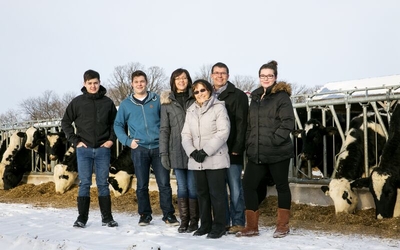In celebration of Canada’s 150th anniversary, Dairy Farmers of Canada has produced a book, Dairy Farmers—Deeply Rooted for a Strong Future that honours Canada’s dairy tradition and the contributions dairy farmers have made to Canada’s emergence as a nation.
 Like many French immigrants escaping poverty in France, the Philippot farm’s founder Alexis Philippot left behind all he knew to start a new life in Canada. Today, his grandson Alain Philippot owns the farm and is the third generation of Philippot farmers.
Like many French immigrants escaping poverty in France, the Philippot farm’s founder Alexis Philippot left behind all he knew to start a new life in Canada. Today, his grandson Alain Philippot owns the farm and is the third generation of Philippot farmers.
Alexis Philippot was 19-years-old when he left his impoverished family in Brittany, France, in 1909 to travel to St. Claude, Manitoba, where a brother had immigrated years earlier. He left behind a country mired in century-old grievances—a legacy of the French Revolution that perpetuated the persecution of Bretons who had remained loyal to the King. Oppressed and poor, knowing he would never see his parents again, Alexis crossed the Atlantic in the hope of starting a better life. He saved enough money to buy land but had to work another five years before he and his new bride, Marie Philippe, could start farming. They were livestock farmers and they gradually expanded their farm to include 1,800 acres of land, which was later divided among their six sons.
When Raymond and Laurette took over Philippot Farms in 1958, the land was depleted. “The first year hay was scarce and the pasture was also exhausted,” says Laurette. In 1958, the Philippots were only shipping three cans of cream a week, which generated very little income—about $25 a week.
Things started to change for them in 1967 with the arrival of supply management, when they started shipping milk. With the abundance of dairy farms in the area, investors from Winnipeg expanded the existing creamery in the 1960s.
The implementation of supply management transformed the local economy. “In the town, they brought in sewers, natural gas, water, and they needed all this for the dairy plant,” Alain explains. “It spearheaded the development of the town.”
“Because we had bad soil, we had cows. Because we had cows, it brought dairy. Because it brought dairy, we got a butter plant. Because we got supply management, then all of a sudden these farms were profitable!”
For as long as he can remember, Alain wanted to be a farmer. His parents had magazines with pictures of tractors and, as a child, he would sit on the pictures. He followed his dad everywhere and slept on the bulk tank while his mom worked in the barn. After he finished university, he bought cows and quota and bought the rest of his father’s farm five years later.
Alain’s love and passion for farming is evident when he talks about continuing his father’s renewal of the land. Since 1958, the Philippots have worked hard to improve the land so it can be passed on to the next generation. They increased organic matter, started crop rotation, and rotational grazing. His grandfather Alexis would look at the soil and say, “the land had life in it and it lost that and now that life is coming back.”
Technology makes farms more efficient, but experience and passed down knowledge remains important. Sustainability is nothing new for farmers, “it’s the art of being a farmer,” Alexis used to say.
Source: Dairy Farmers of Canada









